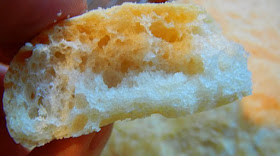Sourdough starter, ready to use. [Teri Carns photo, 4/20/2013.]
Tangy sourdough bread was the perfect food for the gutsy would-be gold barons who poured into Alaska in the 1800s. They slept with their starters, lumps of flour and water alive with yeasts and healthful microbes, in pouches around their necks. In the morning they mixed a nugget of the starter with flour and water, let it rise in a bowl during the day, and baked it in a Dutch oven (a cast iron pot with a lid) over the campfire in the evening. The round, fragrant, golden-crusted loaves satisfied even the hungriest miners.
Sourdough flatbread, fresh from the oven. [Teri Carns, 4/20/2013.]
Few things are more immediately gratifying than buttering a slice of sourdough bread hot from your own oven. Simple and satisfying, sourdough is on CNN's list of the top 50 classic American foods. You can create a starter the same way that gold seekers did. Once your starter is thriving, you can make dozens of simple or complex recipes, from breads and flatbreads to pancakes and muffins. Depending on how often you feed it, the starter will taste sweeter or tangier. Below, you'll find advice from Alaska's premier bakers and a recipe showing how anyone can recreate the flavorful breads.
Sourdough starters are living colonies of yeasts and microbes that feed on the starches and sugars in grains, fruits, or vegetables. Water, oxygen, and the right temperatures keep them thriving. Like other living creatures, they need food and water every day or so, unless they are hibernating in your refrigerator.
Kirsten Dixon of Winterlake Lodge on Alaska’s Iditarod Trail creates a sourdough starter by slicing apples and adding them to a bowl of water with a little sugar. She sets the bowl in a warm spot in her kitchen until the yeasts and bacteria have begun to take root in their new home. Whether you start with apples or all-purpose wheat flour (the most common choice), yeasts and microbes that are always in the air or on the fruit and flour settle into the welcoming environment. As the culture grows, it should smell yeasty (not sour or moldy) and look bubbly and healthy.
Baking with your own sourdough starter makes each bite burst with complex flavors. Leavening dough with natural levains (sourdoughs) keeps loaves fresh for days, says Janis Fleischman of Fire Island Rustic Bakeshop in Anchorage. Your culture's yeasts and microbes grow so well that they prevent invading microbes from gaining a foothold.
Daniel Martin of Wild Oven Bakehouse in Juneau says that the warm, slow, mildly acidic fermentation of natural sourdough leavening releases nutrients locked in the grain, making the bread more digestible. Communities of wild yeasts and microbes accomplish this much better than a single type of commercial yeast. The bright tastes of naturally yeasted sourdough bread signal both a delicious meal and one that uses local ingredients to create healthier food.
Ways of making sourdough starters abound, with some cooks encouraging the use of prepared yeast to boost the activity of the wild yeasts, and others relying entirely on what's found in the air and on the flour that you're using. You can mix in plenty of water or leave the starter dough fairly dry. This straightforward and easy Exploratorium version uses only local wild yeasts. The website explains in detail how to keep your starter healthy and happy once it's going.
Mix 1/4 cup white flour with 2 tablespoons water in a small bowl until it turns into a dough. Knead for about five to eight minutes until springy. Cover the bowl loosely with a towel and let the starter sit in a warm spot for two to three days, until it's moist, wrinkled, crusty and smells sweet.
Throw away any crust, add ½ cup flour and enough water to make a firm dough. Cover and leave for one to two days.
The starter should look new and fresh. Remove any dried dough and add one cup of flour. Cover bowl with damp cloth and leave in warm spot for eight to twelve hours. The starter is ready to use when it looks like a regular fully risen bread dough, and springs back when you poke it with your finger.
Sourdough flatbread, ready to bake. [Teri Carns, 4/20/2013.]
Now you can use the starter in most sourdough recipes by breaking off a small chunk, mixing it with more water and flour, and letting it work its magic in the dough. The recipe gives the correct proportions and directions for making loaves of bread. Many other recipes are available in books and on the Internet.
Sourdough flatbread, ready to eat. [Teri Carns photo, 4/20/2013.]
Save a small piece of the starter in the refrigerator, then refresh it again as above and use it in another recipe. Some starters are more than 100 years old; you can leave yours to the great-great-grandchildren in your will.




No comments:
Post a Comment